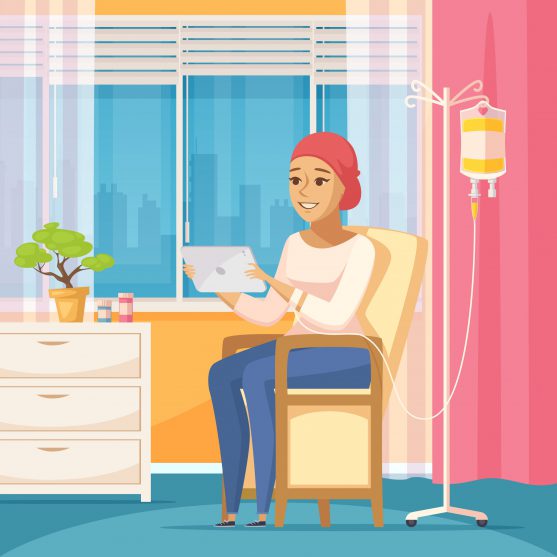When we think of cancer treatment, one of the first things that come to mind is chemotherapy. Though there are many treatments used to treat different cancer types, it is usually a combination of the available options such as radiotherapy, surgical removal of the tumour, targeted drugs etc.

However, chemotherapy is often misunderstood and people get anxious and worried when they hear the word. One of the main reasons for this is that people often highlight the side effects of chemotherapy more than its benefits. So, let’s understand what chemotherapy is all about!
What is Chemotherapy?
As the name suggests, chemotherapy is essentially a treatment that uses drugs that have the capability to kill or destroy rapidly growing cancer cells. Chemotherapy can either be used as the only treatment for a particular type of cancer or as mentioned earlier, in combination with others. It is mostly administered as an intravenous injection and sometimes in oral form.
Why and When is it Used?
Cancer cells are quickly dividing cells that have a tendency to spread to other parts of the body, far from the organ of origin. Treatments such as radiotherapy are region-specific and are used for non-metastasised cancers. However, when the cancer has spread in the body, radiotherapy is not as effective as chemotherapy, which can extend its effect throughout the body.
In doing so, chemotherapy helps in the following:
-
In curing cancer
Chemotherapy drugs help kill cancer cells and in many cases, it helps to cure cancers completely.
-
As an adjuvant therapy
To eradicate the hidden cancer cells that may remain after other treatments such as surgery.
-
As a neoadjuvant therapy
Chemotherapy may be used to shrink the size of the tumour, so that other treatments such as radiation and/or surgery may be possible.
-
Palliative chemotherapy
To ease symptoms – In cases where chemotherapy or any other treatments cannot cure or control the cancer, chemotherapy is used to ease the patient’s symptoms and improve their quality of life to some extent.
Also, when chemotherapy is used in combination with or follows other treatments given to the patients, it is essentially done to make sure that any remaining cancer cells, anywhere in the body are killed too.
You will also be surprised to know that chemotherapy is not just used to treat cancer but also in the treatment of some immune system disorders such as rheumatoid arthritis and lupus. The intensity of chemotherapy drugs used in this case is, however quite low. It is also used to prepare a person’s body for a bone marrow transplant where it is used to eradicate cancerous cells in the blood forming bone marrow.
Preparing for a Chemotherapy
As intimidating or scary as chemotherapy may seem, it is absolutely essential to cure cancer. Before one goes for their chemotherapy appointment, due to the seriousness of the condition as well as the procedure, it is important to prepare for it in advance – both mentally as well as physically. Your oncologist and healthcare team will give you a heads-up about the drugs that will be used and what you can expect during and post the chemotherapy session.
Before the actual therapy begins, each patient is evaluated to check if he/she is healthy enough for chemotherapy. Doctors examine vitals like blood pressure, body temperature, nutritional status and usually advise blood tests like complete blood count with kidney function tests and sometimes liver function tests to understand fitness for chemotherapy administration. Based on the results of these preliminary tests, the oncologist is able to determine suitability for the patient’s chemotherapy. Some other preparations that may be required include:
Dental visit
One of the first things that patients set for chemotherapy are told is to visit their dentist for getting all dental infections treated. The main reason for this is that chemotherapy reduces the body’s immunity and this can complicate matters if there are any existing dental infections. So, it is recommended to get all cavities and gum diseases treated before beginning chemotherapy sessions.
Preparing for an intravenous (IV) chemotherapy
In case an oncologist has recommended IV (into veins) chemotherapy for his/her patient, a catheter is placed in the hand or the arm of the patient. The IV may stay in your vein for a few days. Or your caregiver may need to insert a new IV before each chemotherapy dose. Speaking to your doctor on this to ensure clarity.
When the chemotherapy cycles are expected to last over months, the doctors insert a device called ‘chemo port’ that is placed under the skin on the chest and is connected directly to major veins entering the blood circulation. Whenever chemo is administered, the nurse would insert the needle directly into the chemo port and connect it with the drug dispensing line.
Information about the possible side effects
A lot is spoken about the side effects of chemotherapy. However, not all side effects occur with all chemotherapy drugs and in every patient. Before beginning chemotherapy sessions with a patient, he/she is informed about what side effects one can expect and when. This gives the patient and his/her family members a clear picture of what to anticipate and puts their doubts and fears to rest.
Planning ahead for your home and work schedules
Something that every patient of chemotherapy is informed is the fact that though chemotherapy is given as an outpatient procedure and patients can go about doing their regular jobs and chores, in some cases, the patient might need some help at home and work.
Your first appointment
A patient’s first chemotherapy appointment can be quite scary but with the right information from the healthcare team and oncologist, the appointment stress can be eased out. Patients may be advised to eat a lighter meal and get an ample amount of rest the previous night.
For assistance regarding the treatment, and book priority appointments, you can get in touch with our care managers.
How is chemotherapy performed? (Procedures Involved)
When your doctor recommends a chemotherapy option to help treat your cancer, it is important to understand the goal of the procedure, which helps in making treatment decisions. The dosage and the duration of a chemotherapy procedure will depend on the type and complexity of cancer, and when it is used.
Chemotherapy is administered in various ways, of which some include:
Oral chemotherapy
This includes taking drugs in the form of pills or capsules
Chemotherapy Injections
This is most common method to administer chemotherapy when patients are injected with chemotherapy drugs as part of their treatment. Such injections are either given in veins or through chemo port where the drug directly enters the blood circulation.
Chemotherapy to a specific region of the body
Many a time, chemotherapy drugs are given directly to the affected regions. For example, in the case of some cancers when it has spread extensively within the abdomen, the doctors may operate and irrigate the abdomen with chemotherapy drug to directly treat the cancerous tumours, this technique is called HIPEC; similarly, other types include intrapleural (inside the chest), intrathecal (inside spine), and intravesical (inside urinary bladder).
Based on the mode of administration of chemotherapy, many a time the patient is allowed to take the drugs at home as in the case of oral chemotherapy. The frequency with which chemotherapy is given depends largely upon the type of cancer, stage of cancer, the type of drug and how the body of the patient recovers after each session.
Chemotherapy side effects and risks
This is by far the most common thing that people know about chemotherapy. However, it is often misunderstood and causes cropping of fear in the minds of the patients as well as their family.
Cancer cells grow fast and the chemo drugs are targeted to kill the fast growing cells. When a chemotherapy drug is given, they travel throughout the body and can attack normal, healthy cells that are fast-growing as well. Damage to these healthy cells induces side effects, and it is normal to be cautious during this part of the cancer treatment.
The normal, fast growing cells most likely to be damaged by chemo include the cells of hair follicles, blood forming cells in the bone marrow, and cells in the mouth, digestive tract and the reproductive system.
These side effects can be broadly classified into immediate effects and late effects, based on when these effects appear following a chemotherapy session.
According to the American Cancer Society, here are some of the more common side effects caused by chemotherapy:
- Fatigue
- Hair loss
- Easy bruising and bleeding
- Infection
- Anemia (low red blood cell counts)
- Nausea and vomiting
- Appetite changes
- Constipation
- Diarrhoea
- Mouth, tongue, and throat problems such as sores and pain with swallowing
- Nerve and muscle problems such as numbness, tingling, and pain
- Skin and nail changes such as dry skin and colour change
- Urine and bladder changes and kidney problems
- Weight changes
- Chemo brain, which can affect concentration and focus
- Mood changes
- Changes in libido and sexual function
- Fertility problems
While these side effects appear a few minutes to hours following a chemotherapy session and often resolve by themselves or with minimum intervention in some time. However, some of these side effects are delayed (don’t appear a few months to a few years after treatment) and are more long-lasting.
Loss of hair, as a result of this procedure, is very common. However, the hair grows back after the treatment has been completed.
There is no single guide that can tell you what will happen at your next chemotherapy session or how your body will accept the treatment. But, chemotherapy has been one of the most successful treatments to beat cancer till date and there continue to be many advances in the field to make the entire process more comfortable for the patients while the drugs fight the cancer!



